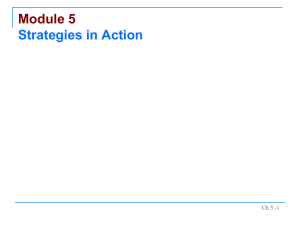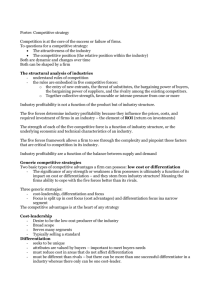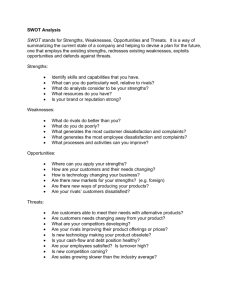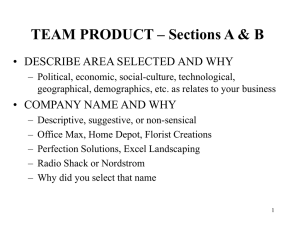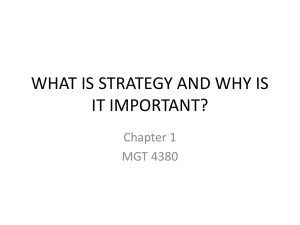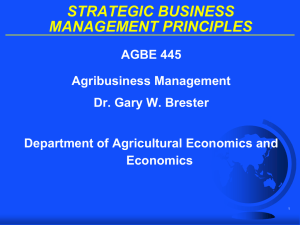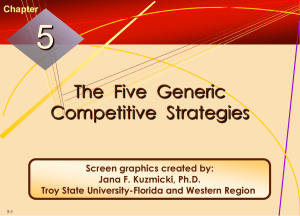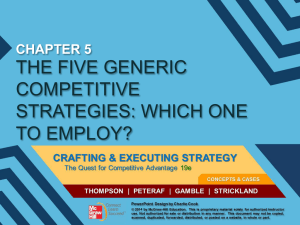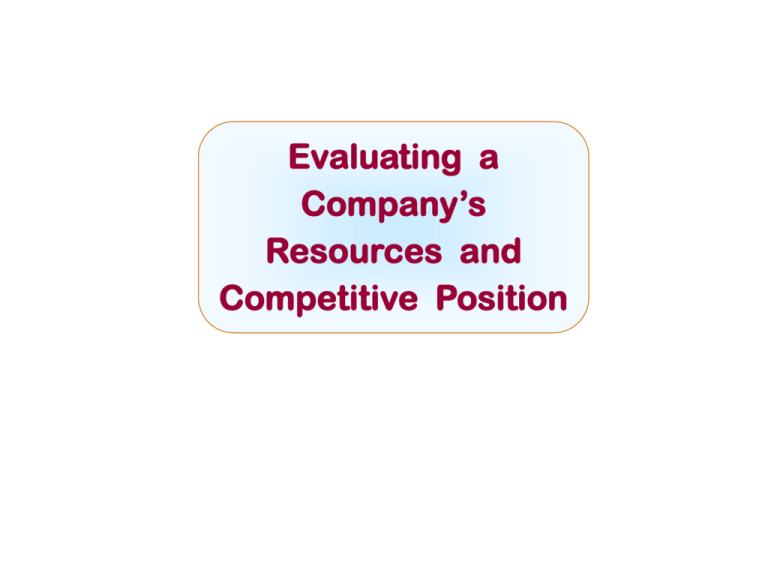
Evaluating a
Company’s
Resources and
Competitive Position
McGraw-Hill/Irwin
Copyright © 2008 by The McGraw-Hill Companies, Inc. All rights reserved.
Question 1: How Well Is the Company’s
Present Strategy Working?
Key Considerations
• Must begin by understanding what the strategy is
– Identify competitive approach
• Low-cost leadership
• Differentiation
• Focus on a particular market niche
– Determine competitive scope
• Broad or narrow geographic market coverage?
• In how many stages of industry’s production/distribution chain does
the company operate?
– Examine recent strategic moves
– Identify functional strategies
Approaches to Assess How Well
the Present Strategy Is Working
• Qualitative assessment –
Is the strategy well-conceived?
– Covers all the bases?
– Internally consistent?
– Makes sense?
– Timely and in step with
marketplace?
• Quantitative assessment – What
are the results?
– Is company achieving its
financial and strategic
objectives?
– Is company an aboveaverage industry performer?
Key Indicators of How Well
the Strategy Is Working
•
•
•
•
•
•
•
•
•
Trend in sales and market share
Acquiring and/or retaining customers
Trend in profit margins
Trend in net profits, ROI, and EVA
Overall financial strength and credit ranking
Efforts at continuous improvement activities
Trend in stock price and stockholder value
Image and reputation with customers
Leadership role(s) – Technology, quality,
innovation, e-commerce, etc.
Question 2: What Are the Company’s Strengths,
Weaknesses, Opportunities and Threats ?
• S W O T represents the first letter in
–
–
–
–
S trengths
W eaknesses
O pportunities
T hreats
S
O
W
T
• For a company’s strategy to be well-conceived, it must
be
– Matched to its resource strengths and weaknesses
– Aimed at capturing its best market opportunities and
erecting defenses against external threats to its well-being
Identifying Resource Strengths
and Competitive Capabilities
• A strength is something a firm does well or an attribute
that enhances its competitiveness
–
–
–
–
–
–
–
Valuable skills, competencies, or capabilities
Valuable physical assets
Valuable human assets
Valuable organizational assets
Valuable intangible assets
Important competitive capabilities
An attribute placing a company in a position of market
advantage
– Alliances or cooperative ventures with partners
Resource strengths and competitive
capabilities are competitive assets!
Competencies vs. Core Competencies vs.
Distinctive Competencies
• A competence is the product of organizational
learning and experience and represents real
proficiency in performing an internal activity
• A core competence is a well-performed
internal activity central (not peripheral or incidental) to
a company’s competitiveness
and profitability
• A distinctive competence is a competitively valuable
activity a company performs better than its rivals
Examples: Distinctive Competencies
Toyota
Starbucks
Low-cost, high-quality
manufacturing of motor
vehicles
Innovative coffee drinks
and store ambience
Determining the Competitive
Power of a Company Resource
• To qualify as competitively valuable or to be the basis
for sustainable competitive advantage, a “resource”
must pass 4 tests:
1. Is the resource hard to copy?
2. Is the resource durable – does it have staying power?
3. Is the resource really competitively superior?
4. Can the resource be trumped by
the different capabilities of rivals?
Identifying a Company’s
Market Opportunities
• Opportunities most relevant to a
company are those offering
– Good match with its financial and
organizational resource capabilities
– Best prospects for profitable
long-term growth
– Potential for competitive advantage
Role of SWOT Analysis in
Crafting a Better Strategy
• S W O T analysis involves more than just developing the 4 lists of
strengths, weaknesses, opportunities, and threats
• The most important part of S W O T analysis is
– Using the 4 lists to draw conclusions
about a company’s overall situation
– Acting on the conclusions to
• Better match a company’s strategy to its
resource strengths and market opportunities
• Correct the important weaknesses
• Defend against external threats
Examine Your Company’s SWOTs
Question 3: Are the Company’s
Prices and Costs Competitive?
• Assessing whether a firm’s costs are competitive
with those of rivals is a crucial part of company
situation analysis
• Key analytical tools
– Value chain analysis
– Benchmarking
Fig. 4.3: A Representative Company Value Chain
Fig. 4.4: Representative Value Chain for an Entire Industry
Example: Value Chain Activities
Pulp & Paper Industry
Timber farming
Logging
Pulp mills
Papermaking
Distribution
Example: Value Chain Activities
Home Appliance Industry
Parts and components manufacture
Assembly
Wholesale distribution
Retail sales
Example: Value Chain Activities
Soft Drink Industry
Processing of basic ingredients
Syrup manufacture
Bottling and can filling
Wholesale distribution
Advertising
Retailing
Albertson’s
Example: Value Chain Activities
Computer Software Industry
Programming
Disk loading
Marketing
Distribution
Developing Data to Measure a
Company’s Cost Competitiveness
• After identifying key value chain activities, the next step
involves determining costs of performing specific value chain
activities using activity-based costing
• Appropriate degree of disaggregation depends on
– Economics of activities
– Value of comparing narrowly defined
versus broadly defined activities
• Guideline – Develop separate cost
estimates for activities
– Having different economics
– Representing a significant or growing proportion of costs
Benchmarking Costs of
Key Value Chain Activities
• Focuses on cross-company comparisons of how certain
activities are performed and costs associated with
these activities
–
–
–
–
–
–
–
–
Purchase of materials
Payment of suppliers
Management of inventories
Getting new products to market
Performance of quality control
Filling and shipping of customer orders
Training of employees
Processing of payrolls
Translating Performance of Value Chain
Activities into Competitive Advantage
• A company can create competitive advantage by
out-managing rivals in performing value chain
activities in either/both of two ways
Option 1: Develop competencies and capabilities
that rivals don’t have or can’t match
Option 2: Do an overall better job than rivals of
lowering combined costs of performing
all the value chain activities
Question 4: Is the Company Stronger
or Weaker than Key Rivals?
• Overall competitive position involves
answering two questions
– How does a company rank relative
to competitors on each important
factor that determines market success?
– Does a company have a net
competitive advantage or disadvantage
vis-à-vis major competitors?
Assessing a Company’s
Competitive Strength vs. Key Rivals
1. List industry key success factors and other relevant
measures of competitive strength
2. Rate firm and key rivals on each factor using rating scale
of 1 to 10 (1 = very weak; 5 = average; 10 = very strong)
3. Decide whether to use a weighted or unweighted rating
system (a weighted system is superior because chosen
strength measures are unlikely to be equally important)
4. Sum individual ratings to get an overall measure of
competitive strength for each rival
5. Based on overall strength ratings, determine overall
competitive position of firm
Question 5: What Strategic Issues
Merit Managerial Attention?
• Based on results of both industry and competitive
analysis and an evaluation of a company’s
competitiveness, what items should be
on a company’s “worry list”?
• Requires thinking strategically about
– Pluses and minuses in the industry
and competitive situation
– Company’s resource strengths and weaknesses and
attractiveness
of its competitive
position
A “good” strategy
must address
“what to do”
about each and every strategic issue!
The Five Generic
Competitive
Strategies
McGraw-Hill/Irwin
Copyright © 2008 by The McGraw-Hill Companies, Inc. All rights reserved.
“Competitive strategy is about being
different. It means deliberately
choosing to perform activities
differently or to perform different
activities than rivals to deliver a unique
mix of value.”
Michael E. Porter
Fig. 5.1: The Five Generic Competitive Strategies
Low-Cost Provider Strategies
Keys to Success
• Make achievement of meaningful lower costs
than rivals the theme of firm’s strategy
• Include features and services in product
offering that buyers consider essential
• Find approaches to achieve a cost advantage
in ways difficult for rivals to copy or match
Low-cost leadership means low overall costs, not just low
manufacturing or production costs!
Approach 1: Controlling the Cost
Drivers
•
•
•
•
•
•
•
•
•
•
Capture scale economies; avoid scale diseconomies
Capture learning and experience curve effects
Control percentage of capacity utilization
Pursue efforts to boost sales and spread costs such as R&D and
advertising over more units
Improve supply chain efficiency
Substitute use of low-cost for high-cost raw materials
Use online systems and sophisticated software to achieve operating
efficiencies
Adopt labor-saving operating methods
Use bargaining power to gain concessions from suppliers
Compare vertical integration vs. outsourcing
Approach 2: Revamping the Value
Chain
• Use direct-to-end-user sales/marketing methods
• Make greater use of online technology applications
• Streamline operations by eliminating low-value-added
or unnecessary work steps
• Relocate facilities closer to suppliers or customers
• Offer basic, no-frills product/service
• Offer a limited product/service as opposed to a full
product/service line
Wal-Mart’s Approach to
Managing Its Value Chain
Institute extensive information sharing with vendors via online systems
Pursue global procurement of some items and centralize most purchasing
activities
Invest in state-of-the-art automation at its distribution centers
Strive to optimize the product mix and achieve greater sales turnover
Install security systems and store operating procedures that lower shrinkage
rates
Negotiate preferred real estate rental and leasing rates with real estate
developers and owners of its store sites
Manage and compensate its workforce in a manner to yield lower labor costs
When Does a Low-Cost
Strategy Work Best?
• Price competition is vigorous
• Product is standardized or readily available
from many suppliers
• There are few ways to achieve
differentiation that have value to buyers
• Most buyers use product in same ways
• Buyers incur low switching costs
• Buyers are large and have
significant bargaining power
• Industry newcomers use introductory low prices
to attract buyers and build customer base
Differentiation Strategies
Objective
• Incorporate differentiating features that cause
buyers to prefer firm’s product or service over
brands of rivals
Keys to Success
• Find ways to differentiate that create value for
buyers and are not easily matched or cheaply
copied by rivals
• Not spending more to achieve differentiation
than the price premium that can be charged
Benefits of Successful
Differentiation
A product / service with unique, appealing
attributes allows a firm to
Command a premium price and/or
Increase unit sales and/or
Build brand loyalty
Which
hat is
unique?
= Competitive Advantage
Types of Differentiation Themes
• Unique taste – Dr. Pepper
• Multiple features – Microsoft Windows and Office
• Wide selection and one-stop shopping – Home Depot,
Amazon.com
• Superior service -- FedEx, Ritz-Carlton
• Spare parts availability – Caterpillar
• Engineering design and performance – Mercedes, BMW
• Prestige – Rolex
• Product reliability – Johnson & Johnson
• Quality manufacture – Karastan, Michelin, Toyota
• Technological leadership – 3M Corporation
• Top-of-line image – Ralph Lauren, Starbucks, Chanel
Signaling Value as Well
as Delivering Value
• Incomplete knowledge of buyers causes them to
judge value based on such signals as
–
–
–
–
–
Price
Attractive packaging
Extensive ad campaigns
Ad content and image
Seller facilities or professionalism and
personality of employees
– Having a list of prestigious customers
• Signals of value may be as important as
actual value when
–
–
–
–
Nature of differentiation is hard to quantify
Buyers are making first-time purchases
Repurchase is infrequent
Buyers are unsophisticated
When Does a Differentiation
Strategy Work Best?
• There are many ways to differentiate a product
that have value and please customers
• Buyer needs and uses are diverse
• Few rivals are following a similar
differentiation approach
• Technological change and
product innovation are fast-paced
Best-Cost Provider Strategies
• Combine a strategic emphasis on low-cost with a
strategic emphasis on differentiation
– Make an upscale product at a lower cost
– Give customers more value for the money
Objectives
• Deliver superior value by meeting or exceeding buyer
expectations on product attributes and beating their
price expectations
• Be the low-cost provider of a product with good-toexcellent product attributes, then use cost advantage
to underprice comparable brands
Focus / Niche Strategies
• Involve concentrated attention on a narrow piece of
the total market
Objective
Serve niche buyers better than rivals
Keys to Success
• Choose a market niche where buyers
have distinctive preferences, special
requirements, or unique needs
• Develop unique capabilities to serve
needs of target buyer segment
Approaches to Defining a Market
Niche
• Geographic uniqueness
• Specialized requirements in
using product/service
• Special product attributes
appealing only to niche buyers
Examples of Focus Strategies
• Animal Planet and History Channel
– Cable TV
• Google
– Internet search engines
• Porsche
– Sports cars
• Cannondale
– Top-of-the line mountain bikes
• Enterprise Rent-a-Car
– Provides rental cars to repair garage customers
• Bandag
– Specialist in truck tire recapping
Your Opinion
Which of the five generic competitive strategies do you
think the following companies are employing:
– The Saturn division of General Motors
– Abercrombie & Fitch
– Amazon.com
– Avon Products
Blue Nile
Stock Price Chart

